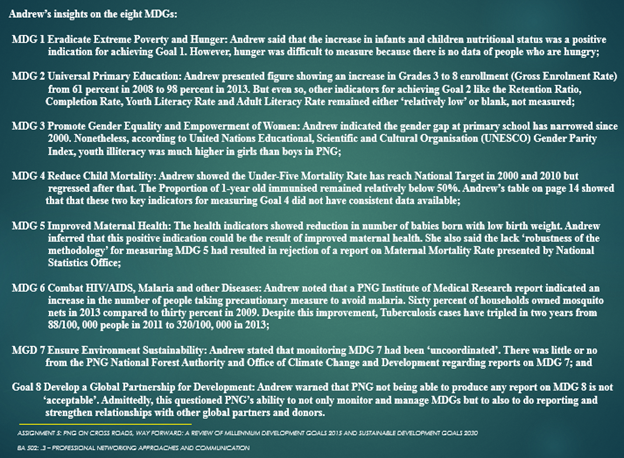In
this review titled ‘A Way Forward: Review
of Papua New Guinea’s Millennium Development Goals 2015 Dismal Performance’
I take a look at three recent articles that address the reasons Papua New
Guinea (PNG) had not performed well in its national tailored Millennium
Development Goal (MDG) targets between 2000 and 2015. The reasons range from
technical to geographical and cultural as well as political. In addition, I
would discuss what PNG could do post-2015 to achieve the United Nations’
Sustainable Development Goals (SDGs) 2030.
2. ARTICLE
1: THE MILLENNIUM DEVELOPMENT GOALS IN PAPUA NEW GUINEA: THE RESPONSE OF
GOVERNMENT
The
article ‘The Millennium Development Goals in Papua New Guinea: the response of government [pdf]’ was written by Marjorie
Andrew, Deputy Director & Research Leader at the National Research
Institute. On the 15th of March, 2015 she presented her research work
at a three-day conference on ‘Resource
Development and Human Well-Being in Papua New Guinea: Issues in the measurement
of progress’. She highlighted several reasons why PNG’s performance on
locally tailored MDGs indicators was ‘off the mark’ (Andrew, 2015, p. 22).
In her remarks on pages 3
- 4, Andrew indicated that PNG national indicators we tailored twice; first in
2004 for the Medium Term Development Strategy 2005 – 2010 and re-tailored in
2010 for Medium Term Development Plan 2011 – 2015. Of the 91 PNG tailored national
indicators, only 40 were the same as the United Nations’ MDGs 1 to 8. The
others (51 tailored indicators) were either blurred or less complying with UN's requirements and therefore cannot be measured internationally. This was of the
reasons why PNG was put in the area of ‘no data’.
On pages 5 - 7, Andrew distinctively pointed
out that the PNG government lacks the internal technical expertise to collect and
analyse important statistical data for the 2015 MDG Progress Report. Though several
departments produced reports annually, overall technical expertise across public
institutions is ‘weak’. She mentioned that PNG’s reliance on international
donors to do reporting showed that without them, vital reports may remain
undone.
3.
ARTICLE
2: MDGS: WHERE DID WE END UP AND WHERE TO FROM HERE?
Dr.
Genevieve Nelson, Chief Executive Officer of Kokoda Track Foundation, gave some
insights on the eight MDGs and put forward several reasons why PNG had
difficulty achieving the MDG indicators. In her introduction, she thought 2015
was ‘...a time to reflect on that past
decade’s [and-a-half] progress towards meeting the goals and setting a new
framework for post-2015’ (Nelson, 2015). Furthermore, she highlighted that
progress was made in the area of poverty reduction worldwide. Quoting McCarter
(2003) she said the estimate for people living under $1.25 per day had halved
from 43 per cent in 1990 down to 21 per cent in 2010 – an indication of a reduction
in poverty. Nonetheless, Dr Nelson said disparity emerged from individual
countries. She clearly indicated that according to the ‘MDG Progress Index
developed by the Centre for Global Development Think Tank’, PNG is awarded a dismal
score of just 1 out of 8.

Dr
Nelson further put emphasis on several challenges why PNG is one of the few
countries in the world that did not meet the MDGs. The two technical reasons she
identified were that the PNG’s tailored development indicators change very
little every few years; and PNG had capacity issues within government offices,
including the government departments. Often there was ‘no data’ in tables due
to their inability to produce reliable data on a regular basis. In addition to
the technical reasons, others reasons that potentially contribute to PNG’s inability
to meet the MDG indicators include Geography, Linguistic and Cultural
diversity, and Governance and Corruption.
Dr.
Nelson remarked that PNG was ranked low on the MDGs Progress Index (1 out of 8)
should be a wake-up call for the government. She reiterated that the ‘business-as-usual’
attitude has to change – there is no room for complacency going forward. PNG
must improve on the technical, geographical, cultural and political challenges,
by developing an appropriate policy framework focused on human development and the provision of services.
In
summary, Dr Nelson said the post-2015 era should see governments, donors,
businesses and NGOs working together to improve people’s lives. Though it may
seem hard, the future of the nation depends on ‘innovation and new technology, collaborations and partnerships, and
strong action focused on the delivery of basic services to remote communities,
to improve outcomes for all Papua New Guineans’ (Nelson, 2015, para. 15).
4. ARTICLE
3: HOW SUSTAINABLE DEVELOPMENT GOALS (SDGs) CAN BENEFIT PAPUA NEW GUINEA’S
SOCIETY AND ECONOMY
The
article was written by Ann-Cathrin Joest for an NGO group called the Seed
Theatre Incorporation. Her emphasis was on how PNG could use its lessons
learned on MDGs as a stepping stone for developing a policy framework for the 17
SDGs, post-2015. Joest introduced her article by stating the obvious - PNG had difficulty
achieving the MDGs. She also mentioned that according to the UN’s Human
Development Index (HDI), PNG is rated among the thirty ‘Low Human Development’
(UNDP, 2014) group of countries, ranked 165 out of 187 countries. She also
mentioned that low life expectancies at birth, school retention, maternal
health, high infant mortality and increase sexually transmitted infections were
among the human development issues. Joest also mentioned that PNG is ranked ‘one of the lowest on the Gender Inequality
Index’ (Joest, 2005. para. 2). In addition, she mentioned that urban crimes
and tribal fights were major challenges.
Joest
reasoned that this poor performance was the result of poor education and food
insecurity; inadequate access to sanitation, clean water and energy; and
failure of past and previous governments on its MDG responsibilities. Joest said
that the MDGs expired in 2015. Yet, under those circumstances, the SDGs2030 policy framework
will not be successful post-2015 if the government does not take action to address
issues relating to education, food security, and institutional capacity among
the others.
Furthermore,
Joest contrasted MDGs to SDGs and thought that ‘previous MDGs did not address the root causes for inequalities and
poverty, [while] SDGs address these through the focus on economic development
and human rights (Joest, 2015, para. 5).
5. SUMMARY
OF ARTICLES: BUILDING CAPACITY IN PUBLIC INSTITUTIONS, A WAY FORWARD
The
three articles, written last year, had identified several reasons why PNG MDG's performance
was dismal. Dr. Nelson is attempting to discuss a way forward through ‘collaborations and partnerships, and strong
action focused on the delivery of basic services to remote communities' (Nelson,
2015, para. 15) in the post-2015 era would improve people’s standard of living. By
the same token, Joest said PNG’s poor performance in MDGs was the result of
poor education and the failure of [past and current] governments to monitor its MDGs
progress (Joest, 2015).
Both
writers have identified three key areas of service delivery: collaboration,
partnership and government responsibilities. However, to work collaboratively
and in partnership with development partners, the public institutions (and
offices) in PNG needed to take their responsibilities seriously (Andrew, 2015).
There is a need for capacity building in the country in view of the fact that
public institutions either needed donor help in reporting MDGs achievements
(Andrew, 2015) or institutional capacity was ‘weak’ (Andrew, 2015) and unreliable.
6. SELF-ASSESSMENT
6.1.
Reflection
on Andrew’s paper
I thought Andrew’s presentation was spot on.
She critically dissected the eight MDGs through her research. She also stated the
obvious fact that the PNG government needed thorough self-examination of its
dismal performance, on the tailored MDG indicators. She further mentioned the
reality that reporting on MDGs progress had been difficult due to a lack of
positive responses from institutional offices like the National Statistics
Office (NSO) and Office of Environment and Conservation (Andrew, 2015, p. 16).
I gather that her use of words such as ‘difficult’ and ‘weak’ was more
diplomatic. But even so, her research experience and the responses showed her
frustration over the lack of capacity from her PNG sources. Though I agree with
most of the facts she produced, she squarely laid the blame on PNG’s
institutional offices she considered to be her data sources for her paper
presentation (Andrew, 2015, p. 16). By way of contrast, little did she
compliment the Department of Education for data on enrolment and retention
(National Education Plan 2005 – 2014 [NEP2005-2014], pp.65 -67), or the NSO
data on Household Income and Expenditure Survey (Andrew, 2015, p.8) she used in
her analyses on MDGs 2 and 1, respectively.
The
point is that though all the data required to compile reports on MDGs were not
available, there was the existence of some form of data in other PNG institutional
offices. As Nelson pointed out, two factors could affect data usage: either there
were few changes over a period of one to two years (Nelson, 2015, para. 8) or
the methodology used at that time to ascertain the use of those data may be
flawed (Nelson, 2015, para. 8). Andrew (2015) inferred that the ‘lack of robustness
of the methodology’ (p. 8) was the reason why the Maternal Mortality Rate (MMR)
produced by NSO was excluded in the MDG Second National Progress Comprehensive
Report 2010. Here, Andrew (2015) saw methodology as the problem rather than
data. Nelson (2015) clearly identified the remedy to this problem (para. 8)
when she implied that methodologies can be adapted, given the type of data
available, to achieve realistic measurements.
6.2.
Reflection on Dr. Nelson’s Article
In
addition to technical reasons such as period of data gathering, methodology for
analysing collected data and capacity issues, Dr. Nelson’s article also delved
into other reasons why PNG had not met the MDGs (Nelson, 2015, para. 8). I
thought she had good insight into PNG’s struggles to achieve the MDGs in the last
15 years when she mentioned other reasons like 'Geography, Linguistic and Cultural Diversity, and Governance and
Corruption’ (Nelson, 2015, para. 8). Even though Nelson was succinct in her
explanations, her summary was either difficult to understand with the use of the
word neo-liberal (Nelson, 2015, para. 11) or generalised when she used phrases
like ‘wake-up call’ and ‘business-as-usual’ (Nelson, 2015, para. 11). By this I
mean she was too technical with little explanation or too loose in her choice
of words. Either way, there was a possibility for her readers to misunderstand or
misinterpret what she intended to say.
6.3.
Reflection
on Joest’s Article
Joest
was explicit in linking the key indicators of MDGs 2015 to SDGs 2030. Her web
article was less academic but more informative. She gave a lot of relevant
opinions on what PNG can do going forward into the SDGs era. She made relevant
connections between each of the 17 goals. For example, ‘With improving poverty (SDG 1), an improvement in malnutrition,
health, education and the economy can take place. With improved food security
and nutrition (SDG2), children or youth can perform better in school. Children
and youth are our future, by investing in their education (SDG4) community
and economic development can take place, better education will generate
increased income which can be directly invested into community health care or
other community needs’ (Joest, 2015, para. 6). In principle, Joest portrayed
an overview of what PNG could do in terms of aligning national policies
framework and termly development strategies and plans going forward (Joest,
2015, para. 6). In saying that, I felt that her article was, more or less, her
personal take on the relevance of SDGs in PNG rather than a practical analysis of
how SDGs could be implemented.
7. CONCLUSION
Finally,
each article showed that PNG performance on its tailored MDG indicators was
dismal. PNG’s nonperformance would only improve if it learned from its past
failures and took a more proactive approach to build capacity within its
public institutions. The writers viewed capacity building at public institutions
as essential for PNG to move forward.
REFERENCES















